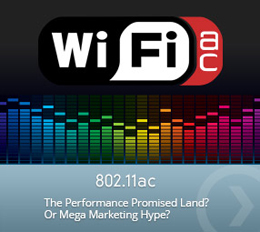
802.11ac
The Performance Promised Land? Or Mega Marketing Hype?
 Boasting maximum data rates near 7 Gbps, 802.11ac cranks up the marketing heat for Wi-Fi. The “gigabit” moniker is producing industry buzz, but the product realities may not live up to the expectations.
Boasting maximum data rates near 7 Gbps, 802.11ac cranks up the marketing heat for Wi-Fi. The “gigabit” moniker is producing industry buzz, but the product realities may not live up to the expectations.
11ac is a 5 GHz only technology, focusing where unlicensed spectrum is both abundant and generally very clean. Building on existing functionality from 802.11n, the major data rate gains of 802.11ac come (theoretically) from simple protocol extensions like wider channels, more spatial streams, and more efficient modulation. Though the industry is optimistic, real-world gains for enterprises may not match the marketing.
Other enhancements like multi-user MIMO (MU-MIMO) will provide significant benefits in the face of capacity strain caused by mobile devices—if Wi-Fi infrastructures are built on the right foundation.
Next-generation Wi-Fi can be a challenge—a product upgrade with limited gains—or an opportunity to enhance business productivity. An optimized 802.11ac infrastructure will depend on solid wireless fundamentals, thoughtful radio design, smart antenna systems, and dynamic RF adaptation. RUCKUS technologies focus in the right direction by making your 802.11ac upgrade worthwhile; we optimize connections, maximize capacity, and reduce cost at the same time.
802.11ac will come to market in phases. Though first-generation products offer some improvements over 802.11n, second-generation products promise true distinction.
Phase 1
When: First half of 2012
What: Nominally 1.3 Gbps — 256-QAM, 80 MHz channels, 3 spatial streams
Phase 2
When: Late 2013, early 2014
What: Nominally 3+ Gbps — MU-MIMO, 256-QAM, 80 and 160 MHz channels, 3+ spatial streams
| Enhancements | |
|---|---|
| 5 GHz Only | Compels device manufacturers to adopt 5 GHz, improving performance, reliability, and overall capacity for the entire Wi-Fi ecosystem |
| 256-QAM | When Wi-Fi signal quality is very good (very close to the AP), more efficient modulation increases data rates by 33% |
| Up to 8 spatial streams | Building on 802.11n’s maximum of 4 spatial streams, 11ac is prepared to support more simultaneous data streams on a channel—when this technology is viable in the future |
| 80 and 160 MHz channels | By increasing channel bandwidth, data rates for individual stations are multiplied and their data transfer efficiency is considerably improved, though aggregate network capacity may decrease in multi-AP environments |
| Multi-user MIMO | MU-MIMO enables simultaneous downlink data streams to different clients at the same time, improving overall channel efficiency. MU-MIMO offloads antenna complexity to the AP (e.g. RUCKUS BeamFlex) and away from clients (e.g. mobile phones) |
| Transmit Beamforming | Building on 802.11n transmit beamforming, 11ac simplifies the implementation and creates an industry standard to improve TxBF adoption |
| Frame Aggregation | By packing larger data payloads in each frame, 11ac boosts overall capacity and efficiency by reducing overhead |
